Corporate Responsibility Case Study - Marks and Spencer
VerifiedAdded on 2023/06/18
|7
|1872
|322
AI Summary
This case study focuses on the Corporate Social Responsibility program of Marks and Spencer, a multinational retail brand dealing in home products, clothing, and food products. The report covers the company introduction, CSR program, stakeholder theory, value creation, and final evaluation. The study highlights the importance of CSR in enhancing the profitability and growth of business.
Contribute Materials
Your contribution can guide someone’s learning journey. Share your
documents today.
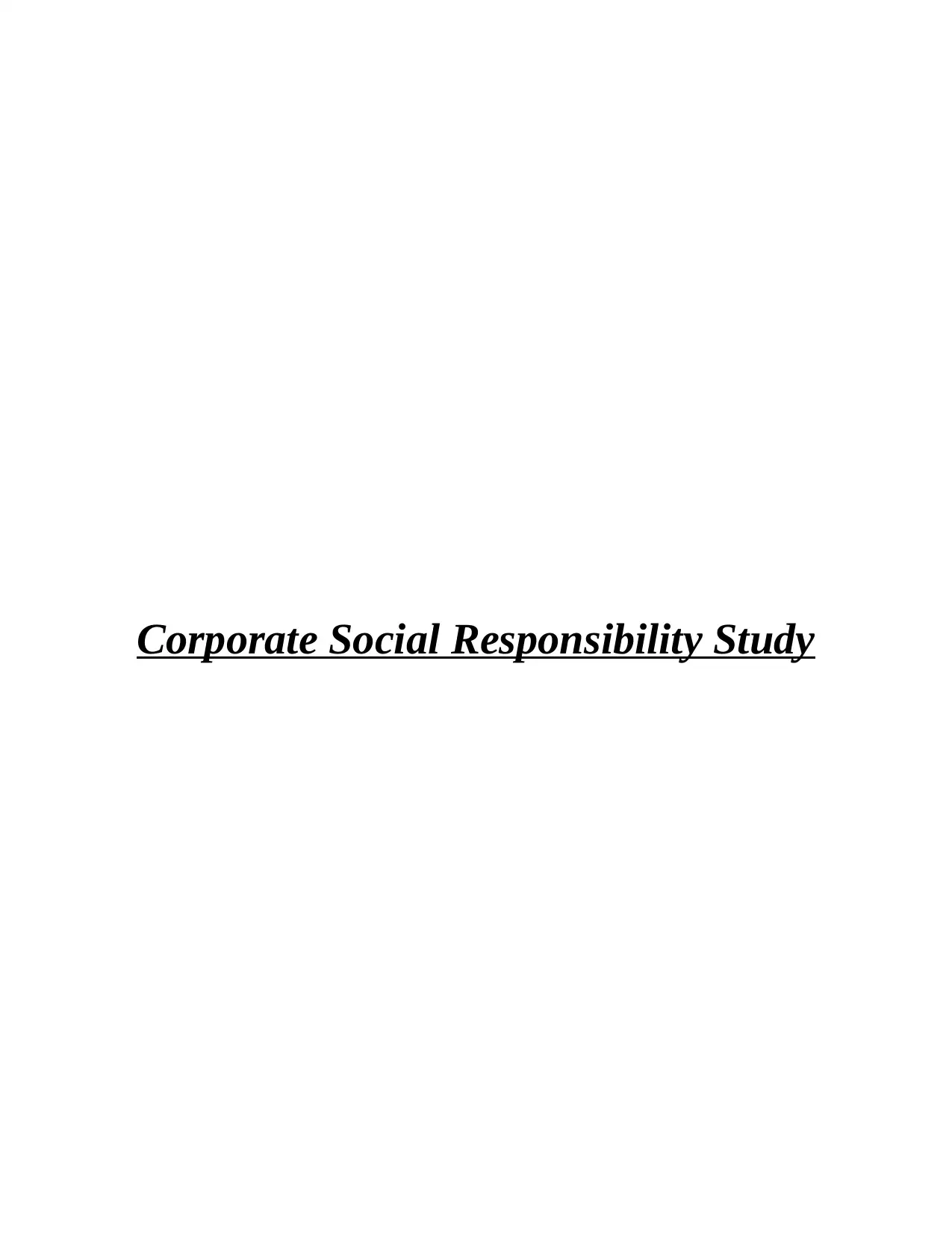
Corporate Social Responsibility Study
Secure Best Marks with AI Grader
Need help grading? Try our AI Grader for instant feedback on your assignments.
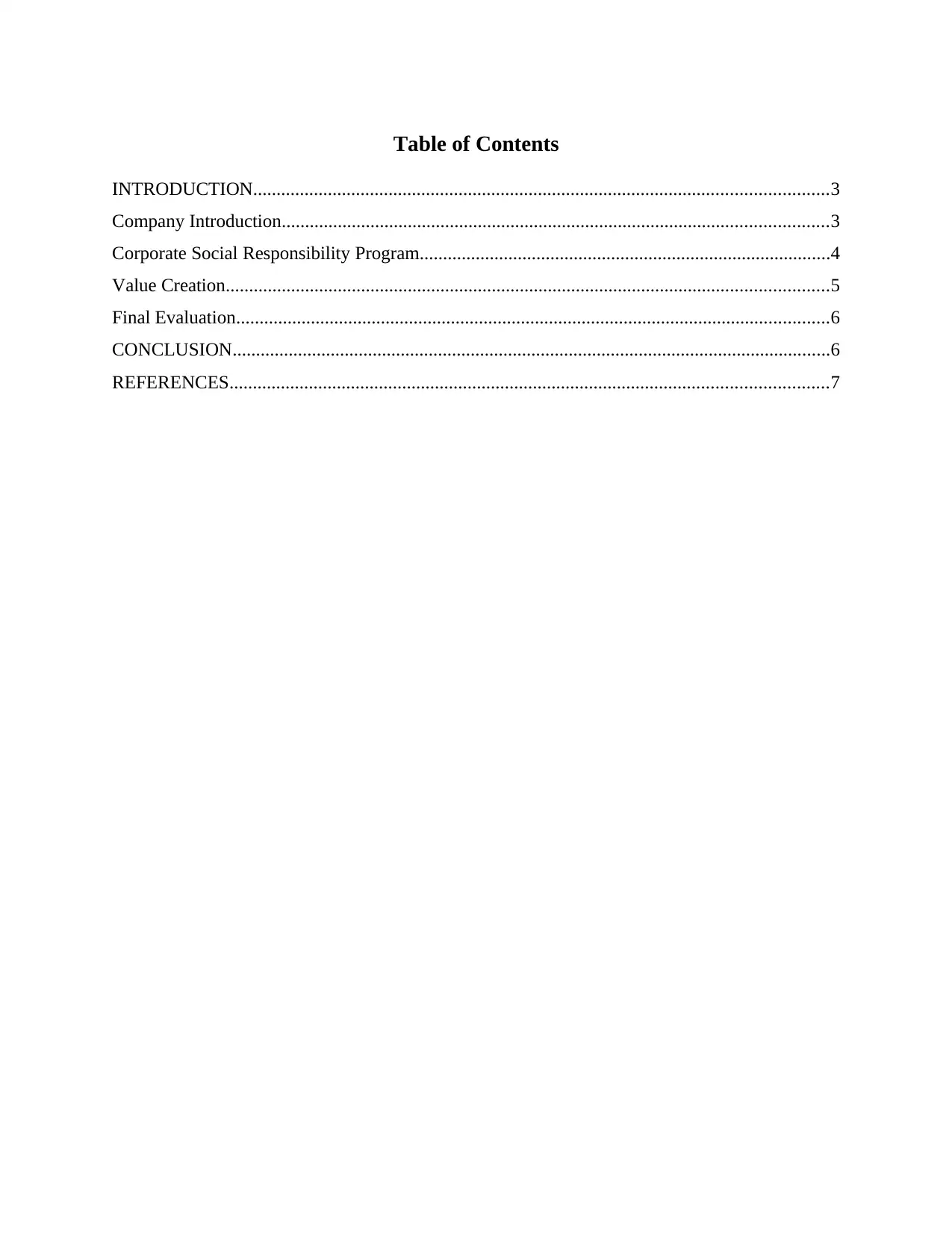
Table of Contents
INTRODUCTION...........................................................................................................................3
Company Introduction.....................................................................................................................3
Corporate Social Responsibility Program........................................................................................4
Value Creation.................................................................................................................................5
Final Evaluation...............................................................................................................................6
CONCLUSION................................................................................................................................6
REFERENCES................................................................................................................................7
INTRODUCTION...........................................................................................................................3
Company Introduction.....................................................................................................................3
Corporate Social Responsibility Program........................................................................................4
Value Creation.................................................................................................................................5
Final Evaluation...............................................................................................................................6
CONCLUSION................................................................................................................................6
REFERENCES................................................................................................................................7
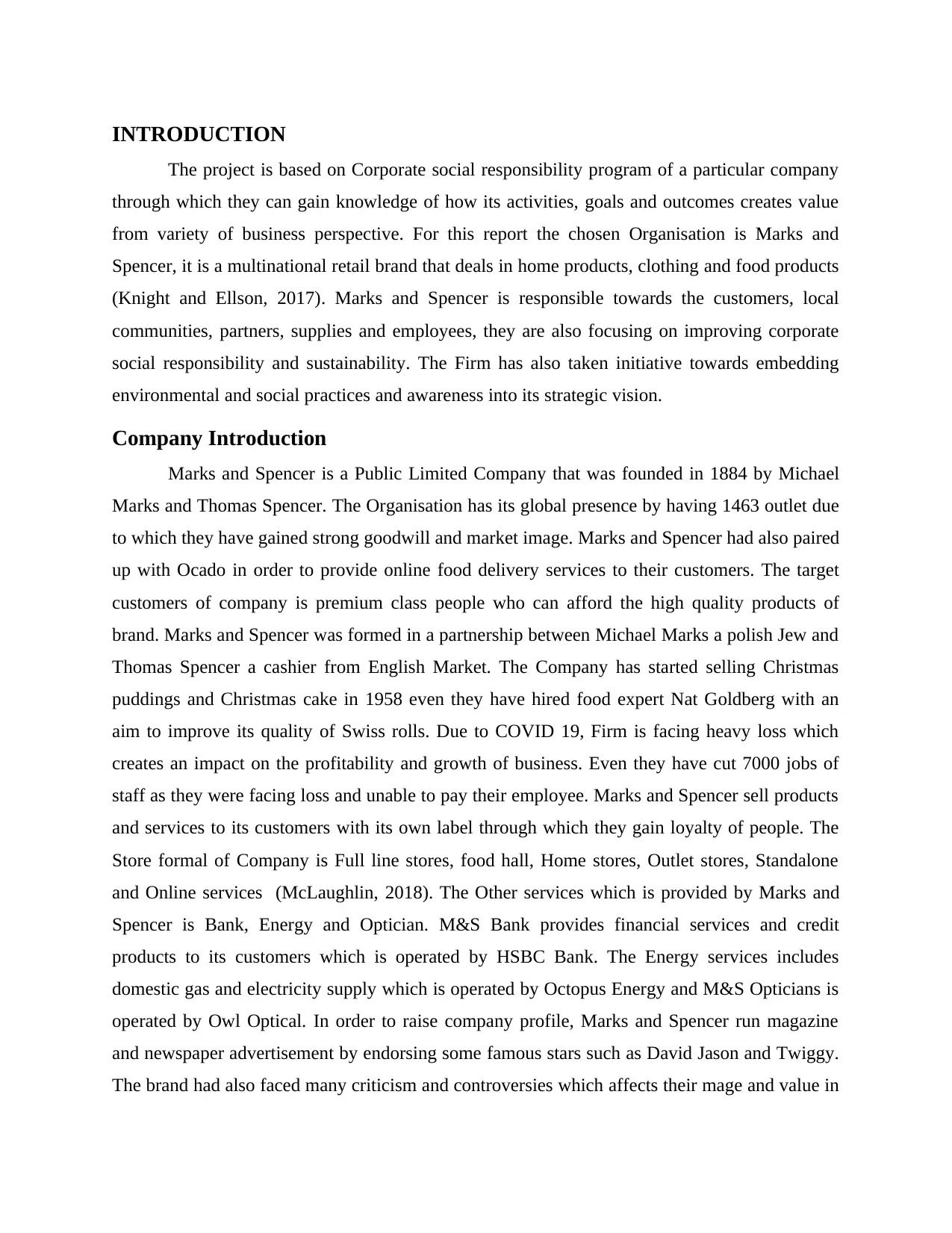
INTRODUCTION
The project is based on Corporate social responsibility program of a particular company
through which they can gain knowledge of how its activities, goals and outcomes creates value
from variety of business perspective. For this report the chosen Organisation is Marks and
Spencer, it is a multinational retail brand that deals in home products, clothing and food products
(Knight and Ellson, 2017). Marks and Spencer is responsible towards the customers, local
communities, partners, supplies and employees, they are also focusing on improving corporate
social responsibility and sustainability. The Firm has also taken initiative towards embedding
environmental and social practices and awareness into its strategic vision.
Company Introduction
Marks and Spencer is a Public Limited Company that was founded in 1884 by Michael
Marks and Thomas Spencer. The Organisation has its global presence by having 1463 outlet due
to which they have gained strong goodwill and market image. Marks and Spencer had also paired
up with Ocado in order to provide online food delivery services to their customers. The target
customers of company is premium class people who can afford the high quality products of
brand. Marks and Spencer was formed in a partnership between Michael Marks a polish Jew and
Thomas Spencer a cashier from English Market. The Company has started selling Christmas
puddings and Christmas cake in 1958 even they have hired food expert Nat Goldberg with an
aim to improve its quality of Swiss rolls. Due to COVID 19, Firm is facing heavy loss which
creates an impact on the profitability and growth of business. Even they have cut 7000 jobs of
staff as they were facing loss and unable to pay their employee. Marks and Spencer sell products
and services to its customers with its own label through which they gain loyalty of people. The
Store formal of Company is Full line stores, food hall, Home stores, Outlet stores, Standalone
and Online services (McLaughlin, 2018). The Other services which is provided by Marks and
Spencer is Bank, Energy and Optician. M&S Bank provides financial services and credit
products to its customers which is operated by HSBC Bank. The Energy services includes
domestic gas and electricity supply which is operated by Octopus Energy and M&S Opticians is
operated by Owl Optical. In order to raise company profile, Marks and Spencer run magazine
and newspaper advertisement by endorsing some famous stars such as David Jason and Twiggy.
The brand had also faced many criticism and controversies which affects their mage and value in
The project is based on Corporate social responsibility program of a particular company
through which they can gain knowledge of how its activities, goals and outcomes creates value
from variety of business perspective. For this report the chosen Organisation is Marks and
Spencer, it is a multinational retail brand that deals in home products, clothing and food products
(Knight and Ellson, 2017). Marks and Spencer is responsible towards the customers, local
communities, partners, supplies and employees, they are also focusing on improving corporate
social responsibility and sustainability. The Firm has also taken initiative towards embedding
environmental and social practices and awareness into its strategic vision.
Company Introduction
Marks and Spencer is a Public Limited Company that was founded in 1884 by Michael
Marks and Thomas Spencer. The Organisation has its global presence by having 1463 outlet due
to which they have gained strong goodwill and market image. Marks and Spencer had also paired
up with Ocado in order to provide online food delivery services to their customers. The target
customers of company is premium class people who can afford the high quality products of
brand. Marks and Spencer was formed in a partnership between Michael Marks a polish Jew and
Thomas Spencer a cashier from English Market. The Company has started selling Christmas
puddings and Christmas cake in 1958 even they have hired food expert Nat Goldberg with an
aim to improve its quality of Swiss rolls. Due to COVID 19, Firm is facing heavy loss which
creates an impact on the profitability and growth of business. Even they have cut 7000 jobs of
staff as they were facing loss and unable to pay their employee. Marks and Spencer sell products
and services to its customers with its own label through which they gain loyalty of people. The
Store formal of Company is Full line stores, food hall, Home stores, Outlet stores, Standalone
and Online services (McLaughlin, 2018). The Other services which is provided by Marks and
Spencer is Bank, Energy and Optician. M&S Bank provides financial services and credit
products to its customers which is operated by HSBC Bank. The Energy services includes
domestic gas and electricity supply which is operated by Octopus Energy and M&S Opticians is
operated by Owl Optical. In order to raise company profile, Marks and Spencer run magazine
and newspaper advertisement by endorsing some famous stars such as David Jason and Twiggy.
The brand had also faced many criticism and controversies which affects their mage and value in
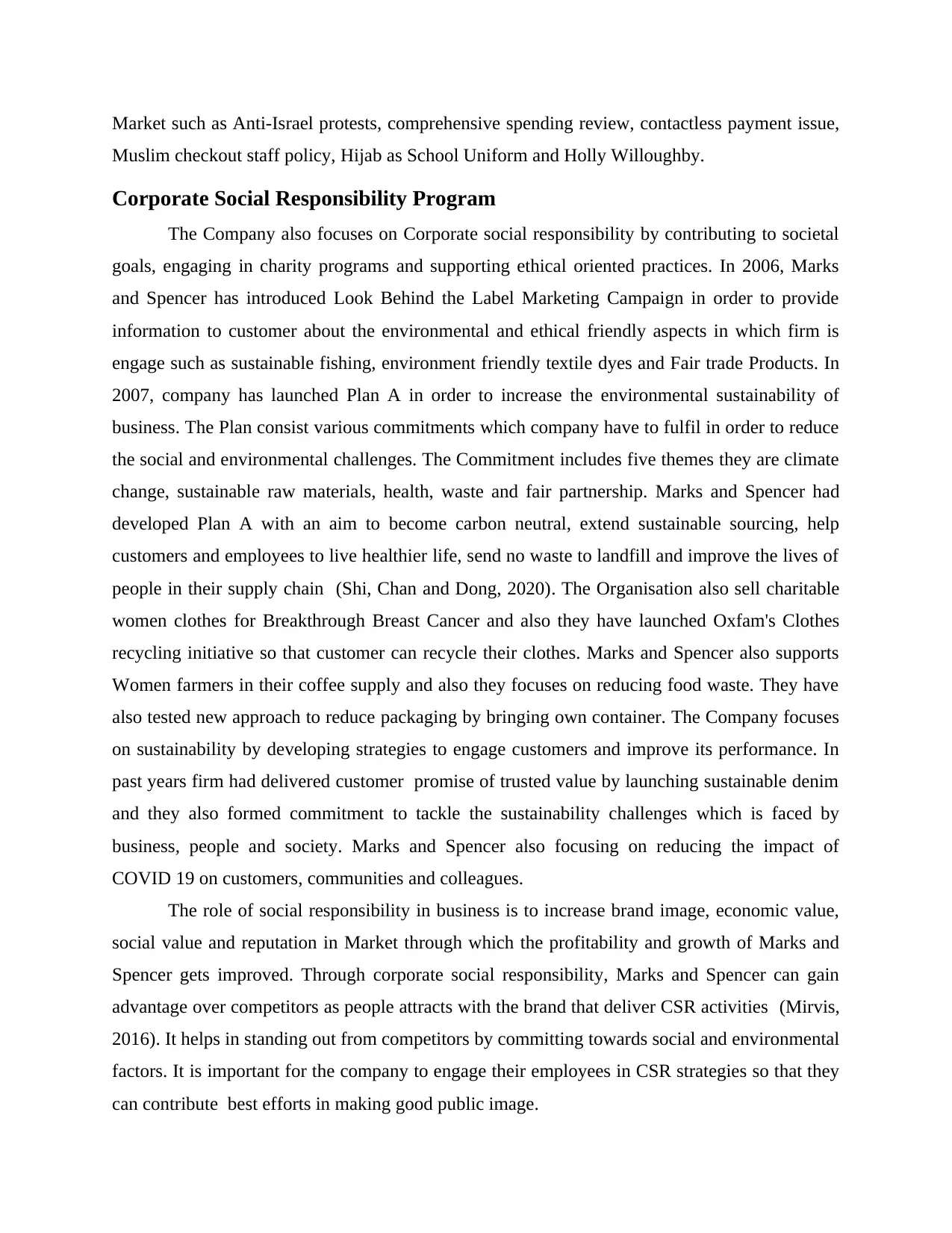
Market such as Anti-Israel protests, comprehensive spending review, contactless payment issue,
Muslim checkout staff policy, Hijab as School Uniform and Holly Willoughby.
Corporate Social Responsibility Program
The Company also focuses on Corporate social responsibility by contributing to societal
goals, engaging in charity programs and supporting ethical oriented practices. In 2006, Marks
and Spencer has introduced Look Behind the Label Marketing Campaign in order to provide
information to customer about the environmental and ethical friendly aspects in which firm is
engage such as sustainable fishing, environment friendly textile dyes and Fair trade Products. In
2007, company has launched Plan A in order to increase the environmental sustainability of
business. The Plan consist various commitments which company have to fulfil in order to reduce
the social and environmental challenges. The Commitment includes five themes they are climate
change, sustainable raw materials, health, waste and fair partnership. Marks and Spencer had
developed Plan A with an aim to become carbon neutral, extend sustainable sourcing, help
customers and employees to live healthier life, send no waste to landfill and improve the lives of
people in their supply chain (Shi, Chan and Dong, 2020). The Organisation also sell charitable
women clothes for Breakthrough Breast Cancer and also they have launched Oxfam's Clothes
recycling initiative so that customer can recycle their clothes. Marks and Spencer also supports
Women farmers in their coffee supply and also they focuses on reducing food waste. They have
also tested new approach to reduce packaging by bringing own container. The Company focuses
on sustainability by developing strategies to engage customers and improve its performance. In
past years firm had delivered customer promise of trusted value by launching sustainable denim
and they also formed commitment to tackle the sustainability challenges which is faced by
business, people and society. Marks and Spencer also focusing on reducing the impact of
COVID 19 on customers, communities and colleagues.
The role of social responsibility in business is to increase brand image, economic value,
social value and reputation in Market through which the profitability and growth of Marks and
Spencer gets improved. Through corporate social responsibility, Marks and Spencer can gain
advantage over competitors as people attracts with the brand that deliver CSR activities (Mirvis,
2016). It helps in standing out from competitors by committing towards social and environmental
factors. It is important for the company to engage their employees in CSR strategies so that they
can contribute best efforts in making good public image.
Muslim checkout staff policy, Hijab as School Uniform and Holly Willoughby.
Corporate Social Responsibility Program
The Company also focuses on Corporate social responsibility by contributing to societal
goals, engaging in charity programs and supporting ethical oriented practices. In 2006, Marks
and Spencer has introduced Look Behind the Label Marketing Campaign in order to provide
information to customer about the environmental and ethical friendly aspects in which firm is
engage such as sustainable fishing, environment friendly textile dyes and Fair trade Products. In
2007, company has launched Plan A in order to increase the environmental sustainability of
business. The Plan consist various commitments which company have to fulfil in order to reduce
the social and environmental challenges. The Commitment includes five themes they are climate
change, sustainable raw materials, health, waste and fair partnership. Marks and Spencer had
developed Plan A with an aim to become carbon neutral, extend sustainable sourcing, help
customers and employees to live healthier life, send no waste to landfill and improve the lives of
people in their supply chain (Shi, Chan and Dong, 2020). The Organisation also sell charitable
women clothes for Breakthrough Breast Cancer and also they have launched Oxfam's Clothes
recycling initiative so that customer can recycle their clothes. Marks and Spencer also supports
Women farmers in their coffee supply and also they focuses on reducing food waste. They have
also tested new approach to reduce packaging by bringing own container. The Company focuses
on sustainability by developing strategies to engage customers and improve its performance. In
past years firm had delivered customer promise of trusted value by launching sustainable denim
and they also formed commitment to tackle the sustainability challenges which is faced by
business, people and society. Marks and Spencer also focusing on reducing the impact of
COVID 19 on customers, communities and colleagues.
The role of social responsibility in business is to increase brand image, economic value,
social value and reputation in Market through which the profitability and growth of Marks and
Spencer gets improved. Through corporate social responsibility, Marks and Spencer can gain
advantage over competitors as people attracts with the brand that deliver CSR activities (Mirvis,
2016). It helps in standing out from competitors by committing towards social and environmental
factors. It is important for the company to engage their employees in CSR strategies so that they
can contribute best efforts in making good public image.
Secure Best Marks with AI Grader
Need help grading? Try our AI Grader for instant feedback on your assignments.
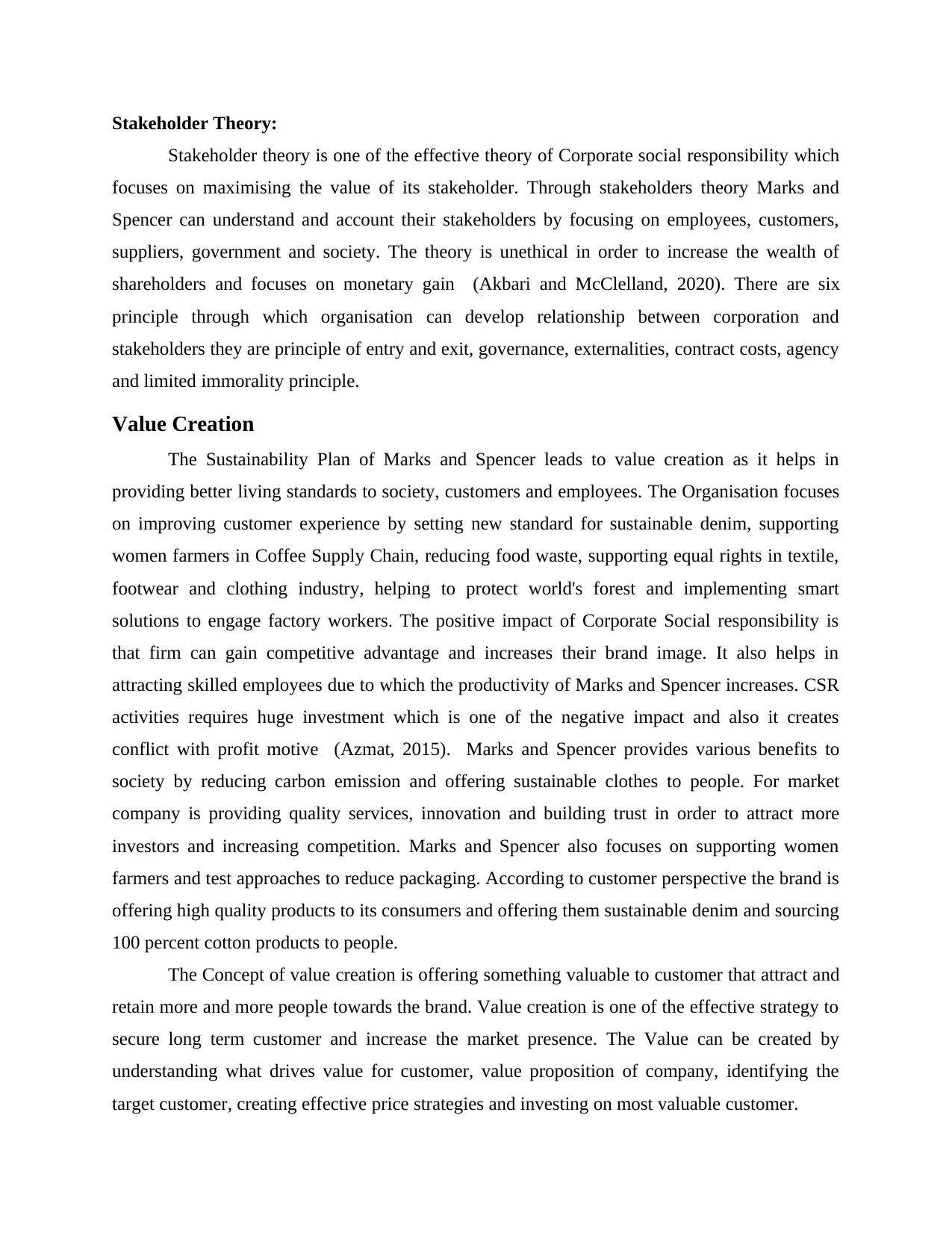
Stakeholder Theory:
Stakeholder theory is one of the effective theory of Corporate social responsibility which
focuses on maximising the value of its stakeholder. Through stakeholders theory Marks and
Spencer can understand and account their stakeholders by focusing on employees, customers,
suppliers, government and society. The theory is unethical in order to increase the wealth of
shareholders and focuses on monetary gain (Akbari and McClelland, 2020). There are six
principle through which organisation can develop relationship between corporation and
stakeholders they are principle of entry and exit, governance, externalities, contract costs, agency
and limited immorality principle.
Value Creation
The Sustainability Plan of Marks and Spencer leads to value creation as it helps in
providing better living standards to society, customers and employees. The Organisation focuses
on improving customer experience by setting new standard for sustainable denim, supporting
women farmers in Coffee Supply Chain, reducing food waste, supporting equal rights in textile,
footwear and clothing industry, helping to protect world's forest and implementing smart
solutions to engage factory workers. The positive impact of Corporate Social responsibility is
that firm can gain competitive advantage and increases their brand image. It also helps in
attracting skilled employees due to which the productivity of Marks and Spencer increases. CSR
activities requires huge investment which is one of the negative impact and also it creates
conflict with profit motive (Azmat, 2015). Marks and Spencer provides various benefits to
society by reducing carbon emission and offering sustainable clothes to people. For market
company is providing quality services, innovation and building trust in order to attract more
investors and increasing competition. Marks and Spencer also focuses on supporting women
farmers and test approaches to reduce packaging. According to customer perspective the brand is
offering high quality products to its consumers and offering them sustainable denim and sourcing
100 percent cotton products to people.
The Concept of value creation is offering something valuable to customer that attract and
retain more and more people towards the brand. Value creation is one of the effective strategy to
secure long term customer and increase the market presence. The Value can be created by
understanding what drives value for customer, value proposition of company, identifying the
target customer, creating effective price strategies and investing on most valuable customer.
Stakeholder theory is one of the effective theory of Corporate social responsibility which
focuses on maximising the value of its stakeholder. Through stakeholders theory Marks and
Spencer can understand and account their stakeholders by focusing on employees, customers,
suppliers, government and society. The theory is unethical in order to increase the wealth of
shareholders and focuses on monetary gain (Akbari and McClelland, 2020). There are six
principle through which organisation can develop relationship between corporation and
stakeholders they are principle of entry and exit, governance, externalities, contract costs, agency
and limited immorality principle.
Value Creation
The Sustainability Plan of Marks and Spencer leads to value creation as it helps in
providing better living standards to society, customers and employees. The Organisation focuses
on improving customer experience by setting new standard for sustainable denim, supporting
women farmers in Coffee Supply Chain, reducing food waste, supporting equal rights in textile,
footwear and clothing industry, helping to protect world's forest and implementing smart
solutions to engage factory workers. The positive impact of Corporate Social responsibility is
that firm can gain competitive advantage and increases their brand image. It also helps in
attracting skilled employees due to which the productivity of Marks and Spencer increases. CSR
activities requires huge investment which is one of the negative impact and also it creates
conflict with profit motive (Azmat, 2015). Marks and Spencer provides various benefits to
society by reducing carbon emission and offering sustainable clothes to people. For market
company is providing quality services, innovation and building trust in order to attract more
investors and increasing competition. Marks and Spencer also focuses on supporting women
farmers and test approaches to reduce packaging. According to customer perspective the brand is
offering high quality products to its consumers and offering them sustainable denim and sourcing
100 percent cotton products to people.
The Concept of value creation is offering something valuable to customer that attract and
retain more and more people towards the brand. Value creation is one of the effective strategy to
secure long term customer and increase the market presence. The Value can be created by
understanding what drives value for customer, value proposition of company, identifying the
target customer, creating effective price strategies and investing on most valuable customer.
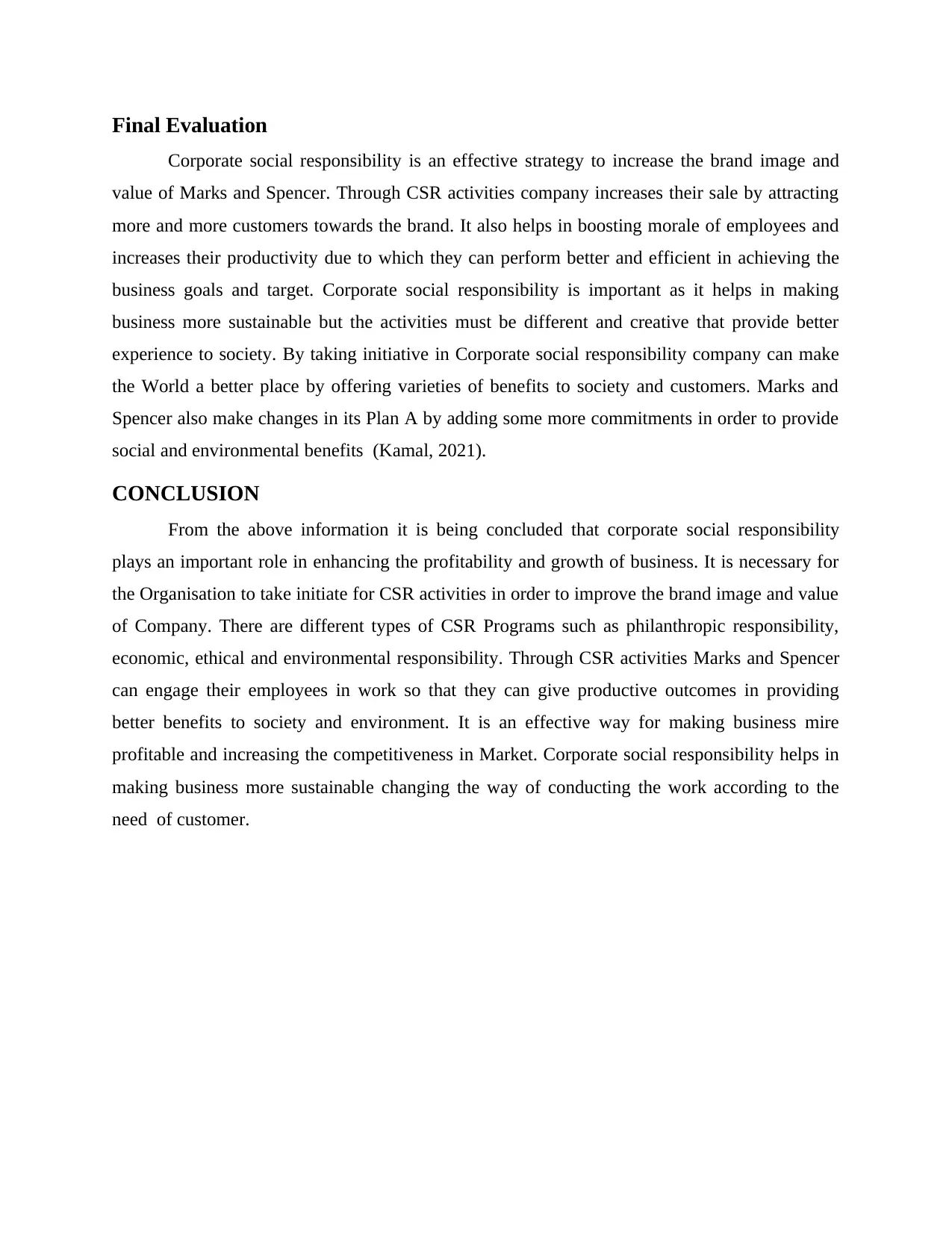
Final Evaluation
Corporate social responsibility is an effective strategy to increase the brand image and
value of Marks and Spencer. Through CSR activities company increases their sale by attracting
more and more customers towards the brand. It also helps in boosting morale of employees and
increases their productivity due to which they can perform better and efficient in achieving the
business goals and target. Corporate social responsibility is important as it helps in making
business more sustainable but the activities must be different and creative that provide better
experience to society. By taking initiative in Corporate social responsibility company can make
the World a better place by offering varieties of benefits to society and customers. Marks and
Spencer also make changes in its Plan A by adding some more commitments in order to provide
social and environmental benefits (Kamal, 2021).
CONCLUSION
From the above information it is being concluded that corporate social responsibility
plays an important role in enhancing the profitability and growth of business. It is necessary for
the Organisation to take initiate for CSR activities in order to improve the brand image and value
of Company. There are different types of CSR Programs such as philanthropic responsibility,
economic, ethical and environmental responsibility. Through CSR activities Marks and Spencer
can engage their employees in work so that they can give productive outcomes in providing
better benefits to society and environment. It is an effective way for making business mire
profitable and increasing the competitiveness in Market. Corporate social responsibility helps in
making business more sustainable changing the way of conducting the work according to the
need of customer.
Corporate social responsibility is an effective strategy to increase the brand image and
value of Marks and Spencer. Through CSR activities company increases their sale by attracting
more and more customers towards the brand. It also helps in boosting morale of employees and
increases their productivity due to which they can perform better and efficient in achieving the
business goals and target. Corporate social responsibility is important as it helps in making
business more sustainable but the activities must be different and creative that provide better
experience to society. By taking initiative in Corporate social responsibility company can make
the World a better place by offering varieties of benefits to society and customers. Marks and
Spencer also make changes in its Plan A by adding some more commitments in order to provide
social and environmental benefits (Kamal, 2021).
CONCLUSION
From the above information it is being concluded that corporate social responsibility
plays an important role in enhancing the profitability and growth of business. It is necessary for
the Organisation to take initiate for CSR activities in order to improve the brand image and value
of Company. There are different types of CSR Programs such as philanthropic responsibility,
economic, ethical and environmental responsibility. Through CSR activities Marks and Spencer
can engage their employees in work so that they can give productive outcomes in providing
better benefits to society and environment. It is an effective way for making business mire
profitable and increasing the competitiveness in Market. Corporate social responsibility helps in
making business more sustainable changing the way of conducting the work according to the
need of customer.
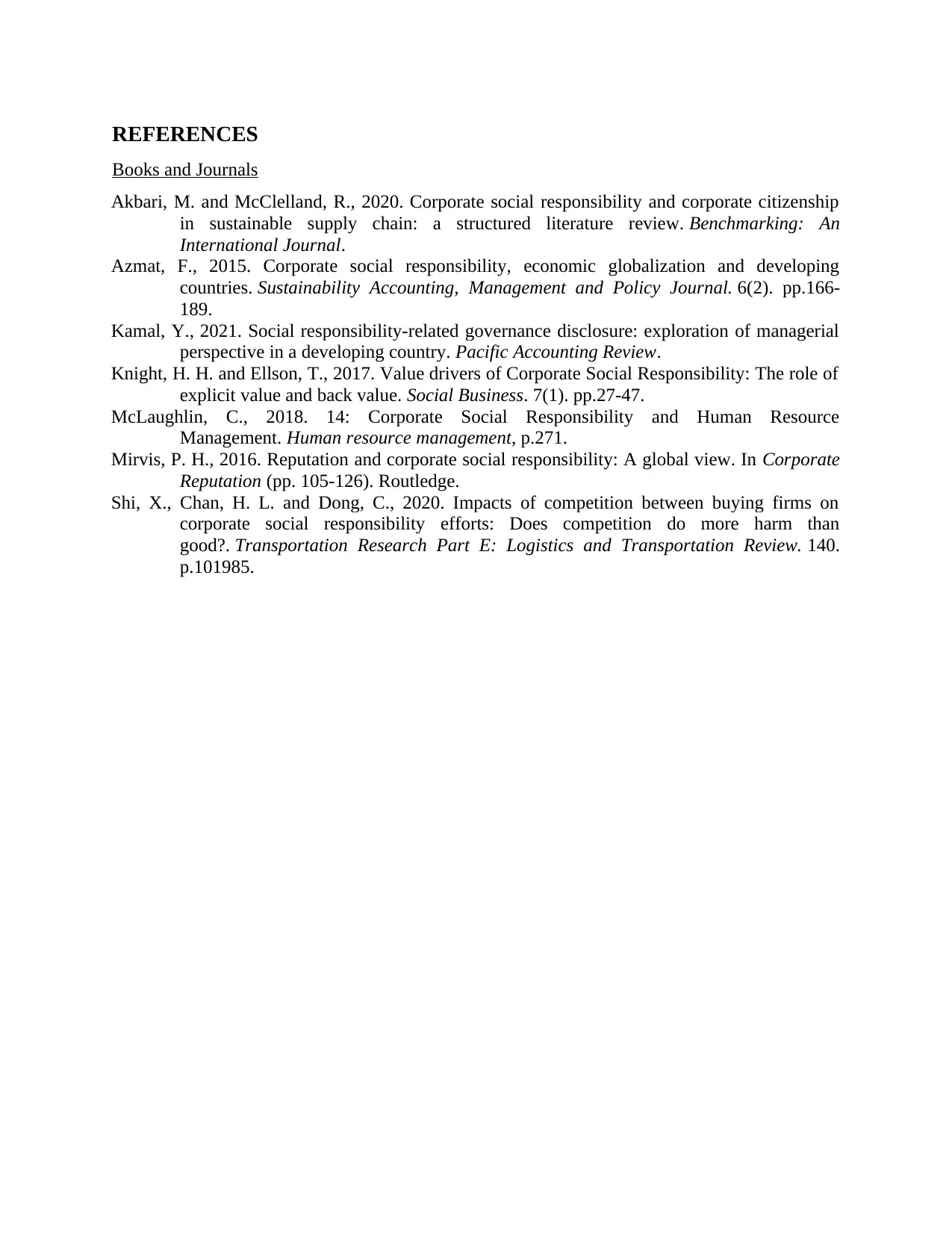
REFERENCES
Books and Journals
Akbari, M. and McClelland, R., 2020. Corporate social responsibility and corporate citizenship
in sustainable supply chain: a structured literature review. Benchmarking: An
International Journal.
Azmat, F., 2015. Corporate social responsibility, economic globalization and developing
countries. Sustainability Accounting, Management and Policy Journal. 6(2). pp.166-
189.
Kamal, Y., 2021. Social responsibility-related governance disclosure: exploration of managerial
perspective in a developing country. Pacific Accounting Review.
Knight, H. H. and Ellson, T., 2017. Value drivers of Corporate Social Responsibility: The role of
explicit value and back value. Social Business. 7(1). pp.27-47.
McLaughlin, C., 2018. 14: Corporate Social Responsibility and Human Resource
Management. Human resource management, p.271.
Mirvis, P. H., 2016. Reputation and corporate social responsibility: A global view. In Corporate
Reputation (pp. 105-126). Routledge.
Shi, X., Chan, H. L. and Dong, C., 2020. Impacts of competition between buying firms on
corporate social responsibility efforts: Does competition do more harm than
good?. Transportation Research Part E: Logistics and Transportation Review. 140.
p.101985.
Books and Journals
Akbari, M. and McClelland, R., 2020. Corporate social responsibility and corporate citizenship
in sustainable supply chain: a structured literature review. Benchmarking: An
International Journal.
Azmat, F., 2015. Corporate social responsibility, economic globalization and developing
countries. Sustainability Accounting, Management and Policy Journal. 6(2). pp.166-
189.
Kamal, Y., 2021. Social responsibility-related governance disclosure: exploration of managerial
perspective in a developing country. Pacific Accounting Review.
Knight, H. H. and Ellson, T., 2017. Value drivers of Corporate Social Responsibility: The role of
explicit value and back value. Social Business. 7(1). pp.27-47.
McLaughlin, C., 2018. 14: Corporate Social Responsibility and Human Resource
Management. Human resource management, p.271.
Mirvis, P. H., 2016. Reputation and corporate social responsibility: A global view. In Corporate
Reputation (pp. 105-126). Routledge.
Shi, X., Chan, H. L. and Dong, C., 2020. Impacts of competition between buying firms on
corporate social responsibility efforts: Does competition do more harm than
good?. Transportation Research Part E: Logistics and Transportation Review. 140.
p.101985.
1 out of 7
Related Documents
Your All-in-One AI-Powered Toolkit for Academic Success.
+13062052269
info@desklib.com
Available 24*7 on WhatsApp / Email
![[object Object]](/_next/static/media/star-bottom.7253800d.svg)
Unlock your academic potential
© 2024 | Zucol Services PVT LTD | All rights reserved.




